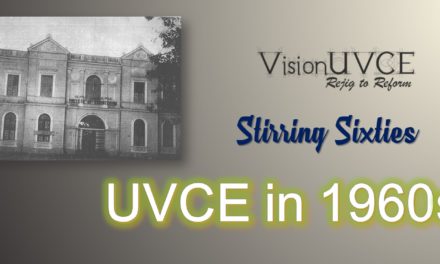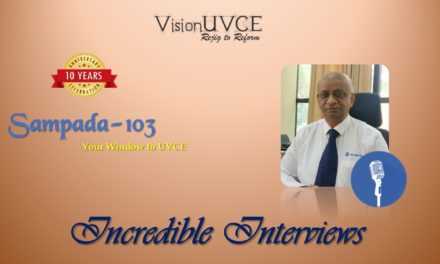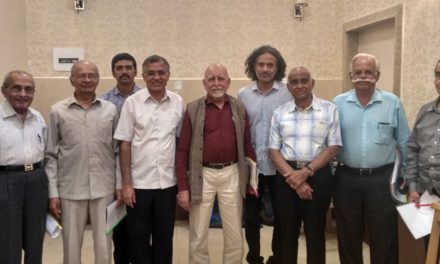Extract of the Address at the College of Engineering, Bangalore by Sir M Visvesvaraya, from few old editions of Sampada
The College of Engineering was started in the year 1917. It came into existence because the Engineering College at Madras and Poona were not able to provide seats for the number of students for whom Mysore wanted provision. As far as I can remember, we wanted admission for ten students annually but the authorities in Madras and Poona could provide only for two or three. Thereupon we decided to start a College of our own in Bangalore City. Mr. K. R. Seshachar, Retired Chief Engineer, Mysore, was appointed the First Principal, and subsequent Principals and Professors have been mostly Mysore Engineers.
The College is at present being maintained in a satisfactory condition. Owing to limitations in accommodation and the great demand for engineering education, three other Colleges have since sprung up in the State. The B. M. S. College of Engineering, Bangalore was started in 1945 by a successful industrialist, the late Mr. B. M. Srinivasiah. A third College in Mysore, the National Institute of Engineering, owe its establishment to the enterprise of a number of patriotic retired officers and leaders of Mysore City. A fourth College the B.D.T. College of Engineering was started by Government in 1951 at Davangere as a result of the persistent demand of the commercial community of that town.
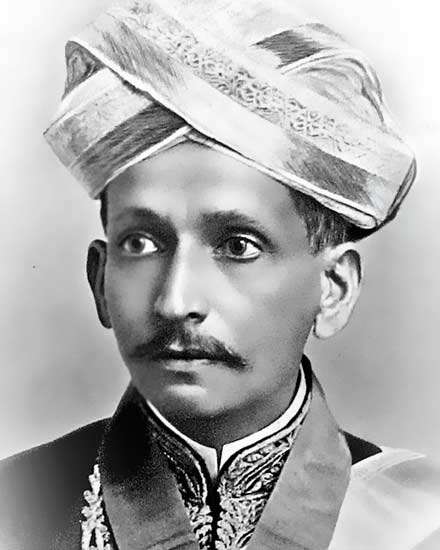
The present position of Engineering Education in Mysore has some defects on account of shortness of funds and other causes but on the whole it is rendering very useful service to the country. The College have been supplying Engineering Graduates for service both in Mysore and in various other parts of India. The total strength of students in all the four Colleges is reported to be 2,414 at present, of whom 838 belong to this College.
In the literature of scientific associations in the West, engineering is defined “as the art of directing men and controlling the forces and materials of nature for the benefit of the human race”. In other words, engineering is the science and the art of planning, constructing and arranging structures of various kinds. When a person is educated as an engineer, he will be qualified to do some work of any of these classes. The work may help him to obtain employment and income for himself. It may help the country in increasing products of value of various kinds.
An engineer is trained to design and carry out works, generally of public utility or business enterprise, with the maximum of efficiency and economy.
The economic aspect is emphasized in the American colloquial definition of an engineer as “a person who does for a dollar what any darned fool can do for two”.
I recently had occasion to consider how many important sections or divisions there were in the present day engineering profession. I found that at least 20 branches of engineering were receiving attention at the present time. The more important of these are:-
Civil Engineering ; Mechanical Engineering; Electrical Engineering; Hydro-Electric Engineering; Marine Engineering; Mining Engineering; Sanitary Engineering; Power Engineering; Topographical Engineering; Chemical Engineering; the newly developing Nuclear Engineering. and so on.
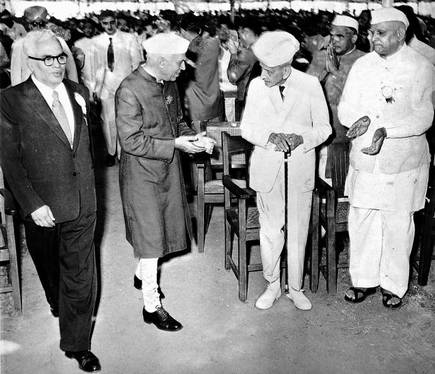
For the present, that is, for 15 or 20 years more, the men who follow this profession in any of its branches in the English language are likely to earn a substantial living, because they will be creating valuable products and income for the country in which they live.
Hitherto Government tendency has been to import machinery in large quantities; latterly foreign technicians are also being employed in addition. This diminishes the chances of our technical experts developing their thinking and creative power. By the import of foreign machinery, crores of money are going out of the country.
So long as this handicap is maintained, there will be a check on the growth of technical knowledge and enterprise in the country.
There are men in this country like the late Walchand, Birlas and the Tatas who have shown great enterprise and developed big works. Many such men will come to the front if sufficient encouragement is given to enterprise. I have mentioned more than once before the cases of Dr Rm. Alagappa Chettiar of Madras and Mr. G. D. Naidu of Coimbatore.
We have a large population and the country is backward ion industries. There is an enormous amount of work to be done. Business public are keen on it. At the present time, very large sums of money are spent both by the Government and the public on the purchase of automobiles, aircraft ,
many kinds of machines like locomotives and other machinery.
It is a fairly long-standing complaint that the production of steel, automobiles and aircraft has been unnecessarily delayed although private effort had advanced them to a material extent without the support of Government. On the whole, rapid industrialization is one of the most urgent needs of the country.
Government exercise too much control and private initiative and activities are thereby materially restricted. In India, however, Government want to supervise important technical works, in some cases without technical knowledge in the men put in charge of them.
There is a very large population without employment for many months in the year. In Western countries population is taken as an asset because it is educated. In India it often constitutes a burden.It is not sufficiently educated and used for productive and creative purposes, benefiting the country, as is done in most Western countries.
I hope that the serious nature of this defect will be taken into consideration and that every effort will be made to educate our people, particularly workers as Russia and Japan have done as a preliminary step to productive activities. Special consideration should be given also to compulsory education and mass education.
Technical or vocational education should be considered in three grades as under:
- Training of an adequate number of technologists or experts of high technical ability in various arts and professions.
- Training secondary grade technicians and businessmen to prepare them for work of foremen, managers and upper subordinates of factories and business concerns.
- Training artisans, craftsmen and businessmen to supply actual workers for all occupations and trades including subsidiary professions like accountancy and estimating.
The last class, that is, artisans, skilled workmen, farmers, smiths, carpenters, small shopkeepers and salesmen, etc., will have to be trained by millions, in all parts of the country.
The relative numbers to be trained under each of the three grades for any region should be arranged by calculation based on the needs and requirements of the occupations of profession as is done in advanced Western countries and Japan.
What Russia did to industrialize is significant in this connection. Ambitious training schemes were launched and special technical schools and colleges of University standing established. These were supplemented by factory schools where shorter courses of instructions were given. As a result, over a period of two quinqennia the number of skilled mechanics is reported to have increased fourfold and industrial scientists sevenfold. During a visit to Salt Lake City in America a long time ago I noticed that the subjects of vocation, Elements of Mechanical Engineering and of Commerce were being taught in High Schools.
The President of the famous Massachusetts Institute of Technology told me that they were giving the highest education in Engineering and he wanted that these students should be in close touch with industries to give them a practical, businesslike start in future Engineering works. He found it difficult to carry out this part of the programme on account of insufficient industries in the neighborhood.
In this country, at the present time, equipment for practical work of this kind is most necessary. Education should be developed on lines which will best serve her immediate purpose. Routine imitations of even the best countries will not help us so long as the majority of our countrymen remain illiterate and the equipment of the educational institutions happen to be poor.
A highly practical enterprise and superior quality of every kind of work in the country, encouragement from both Government and leading public businessmen is required. People who show enterprise by starting big works & giving employment to hundreds of workers should be specially encouraged by Government. The employment opportunities of the many depend upon the willingness of the few to take risks. Western countries have got on well because their Govts encourage enterprise. In India on the other hand, there is too much control exercised & depression created, particularly by the threat of nationalization.
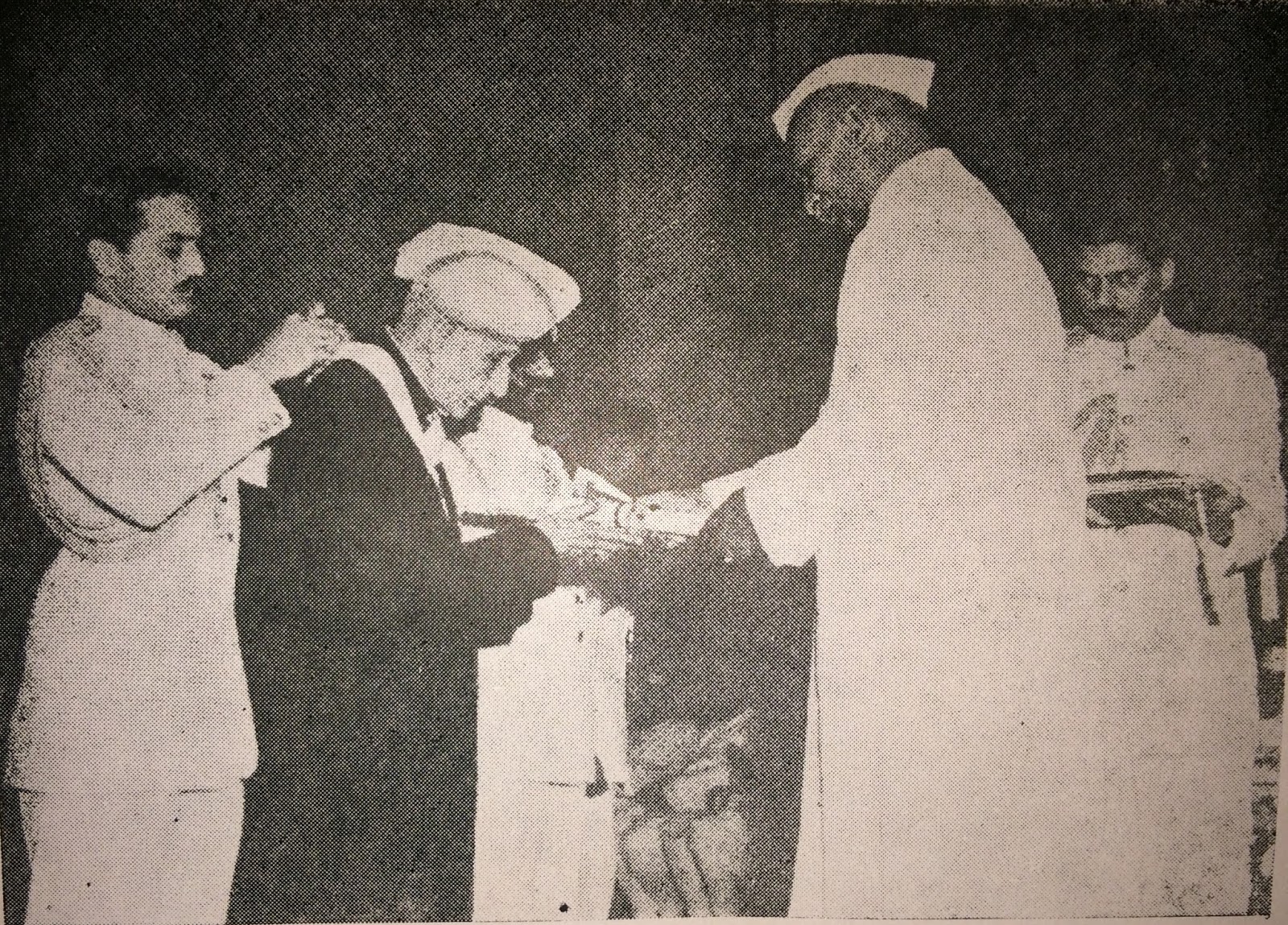
In order that work of good quality may thrive, Government should give encouragement in the shape of grants, rewards, subsidies, remission of taxes and credit facilities, according to the special circumstances of each case. Industries in India require encouragement by leaders who believe in selfhelp, co-operative effort and competitive enterprise on a large scale.
At the present time, the Five-Year Plan of Government required special consideration. It was started with an estimate of Rs. 2,069 crores to which a sum of Rs. 180 crores was subsequently added. The total amount spent in the last three years is about Rs. 885 crores, leaving a balance of Rs. 1,364 crores to be spent in the current and the next official year. Government are projecting a Second Five-Year Plan from 1956-1961, the capital expenditure envisaged being of the order of Rs. 5,000 to 5,500 crores.
It is gratifying to learn that special attention will be paid to the development of industries in this Plan. The experience of the working of the First Five-Year Plan suggests that there is necessity for the adoption of a stricter system of administration and supervision of the operation under the Plan.
We have to remember that works have to be carried on with a majority of illiterate workers and there are bad traditions. These traditions added to illiteracy of workers will always give trouble in long term Plans. The methods of operation have to be changed according to the present circumstances of the country. A method which is considered suitable is as follows:-
- Before beginning operation in any particular year, a separate one-year plan should be prepared based on the Five-Year Plan. It is should be done for each of the Five years of the Plan according to the precise conditions of progress of works at the beginning of each year.
- The officers and contractors employed on the works should be asked to go into the details of projects sought to be entrusted to them and satisfy themselves that the estimated cost and time provided are reasonable. There should be understanding of the precise progress to be attained from quarter to quarter.
- After a work is put into operation in the year, inspection should be made at the end of each quarter year by Scrutiny Committee consisting of three persons of known probity and capacity maintained for the purpose.
If the work is satisfactory, the same staff may be continued. If, on the contrary, there is neglect or inadequate progress, an alarm should be raised by the Committee so that men in charge may be changed and further revised arrangements made to ensure progress according to programme. Consideration should of course be given when any unforeseen defects and handicaps have been encountered during the quarter.
Under this arrangement the responsibility will be thrown also on the officers and contractors in immediate charge of the work. Unless the element of fear or hope is introduced in this Manner and honest effective supervision maintained, satisfactory progress of the plan cannot be ensured.
I am informed that the Government of India have sanctioned a grant of Rs. 10 lakhs to the four Engineering Colleges in the State on condition that the Colleges restrict the number of annual admissions to a total of 360 students in all against 614 admitted last year. The Government have
done this with a view to increasing efficiency and orders seem to have been issued on the recommendations of a Committee.
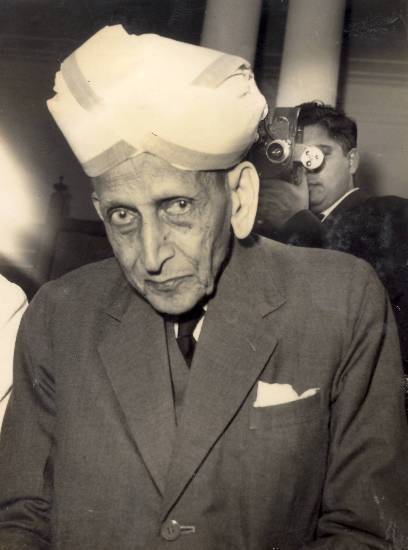
The usual practice when a grant is given is to increase facilities for admissions. Reduction in this case would be unfortunate in more respects than one as there is a great demand for engineering education at present. The past freedom given to these Colleges, it is universally admitted, has done much good and brought remunerative employment to many young men. It seems premature to bring in restrictions to admissions at this stage.It seems desirable to leave the number of admissions at the present level, unaffected for perhaps another six years, until there is a surfeit in the supply of engineers in Mysore & neighbouring States.
CONCLUSION
The Institution was started as stated above more than 37 years ago, in the time of the Late Maharaja his Highness Sri Krishnaraja Wadiyar Bahadur. On such occasion as this we must tender our tribute of respect and gratitude to his honored name for the keen interest he took in the establishment of such useful institutions and the great good he has done for the state. I am sure you are all glad to see the Chief Minister, Mr. K.Hanumanthaiya, here today. It may be taken as an evidence of his great interest in the welfare of such institutions and of his readiness to do all he can to foster their growth and prosperity.
The college has developed satisfactorily. It is at present meeting nearly all the responsible engineering requirement of the Mysore State. The College itself is now staffed completely by Engineers trained within the institution. Three members of the staff , one the Principal Mr. K. Channabasavaiah and two other professors were first educated in this college and they enlarged their knowledge by further studies in America. The teaching seems to be satisfactory and popular. The State Department of Public Works is also entirely equipped with engineers and officers mostly trained locally.
Men trained in the four Engineering Colleges in Mysore are working in newly started Government works as well as in big private enterprises both within and outside the State. Some like Mr. P. S. Char and Mr. M. R. Varadarajan have established themselves as successful Contractors on large Government Public Works and big private enterprises on the Bombay side. The Engineers first employed in Mysore were educated in Madras and Poona Engineering Colleges. Some of the more efficient officers of this
class I have met with were Mr. K. R. Sheshachar, Mr. M. G. Rangaiya and the late Mr. K. Krishna Iyengar. The scope for employment for Engineers can be visibly enlarged if Consulting Engineering Firms are established in important States of the Country.
I will conclude by thanking heartily the Principal of the College and Mr. P. S. Char one of the very first students of the institution for their enthusiastic reference to their Alma Mater and their gratitude for the great good it has done them and old students of their class.
The College has done appreciable good already and I have no doubt that it will continue always to strive to raise its efficiency and reputation as one of the leading educational institutions of the country.

